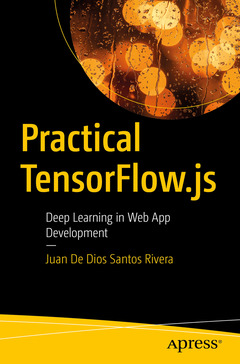Practical TensorFlow.js, 1st ed. Deep Learning in Web App Development
Auteur : Rivera Juan De Dios Santos

- Build deep learning products suitable for web browsers
- Work with deep learning algorithms such as feedforward neural networks, convolutional neural networks (CNN), recurrent neural networks (RNN), and generative adversarial network (GAN)
- Develop apps using image classification, natural language processing, object detection, dimensionality reduction, image translation, transfer learning, and time series analysis
Chapter 1
Welcome to TensorFlow.js
Headings
● What is TensorFlow.js?
● TensorFlow.js API
○ Tensors
○ Operations ○ Variables
● How to install it
● Use cases
Chapter 2
Building your First Model
Headings
● Building a logistic regression classification model
● Building a linear regression model
● Doing unsupervised learning with k-means
● Dimensionality reduction and visualization with t-SNE and d3.js
● Our first neural network
Chapter 3
Create a drawing app to predict handwritten digits using
Convolutional Neural Networks and MNIST
Headings
● Convolutional Neural Networks
● The MNIST Dataset
● Design the model architecture
● Train the model
● Evaluate the model
● Build the drawing app
● Integrate the model within the app
Chapter 4
"Move your body!" A game featuring PoseNet, a pose estimator model
Headings
● What is PoseNet?
● Loading the model
● Interpreting the result
● Building a game around it
Chapter 5
Detect yourself in real-time using an object detection model trained in
Google Cloud's AutoML
Headings
● TensorFlow Object Detection API
● Google Cloud's AutoML
● Training the model
● Exporting the model and importing it in TensorFlow.js
● Building the webcam app
Chapter 6
Transfer Learning with Image Classifier and Voice Recognition
Headings
● What's Transfer Learning?
● MobileNet and ImageNet (MobileNet is the base model and ImageNet is the training set)
● Transferring the knowledge
● Re-training the model
● Testing the model with a video
Chapter 7
Censor food you do not like with pix2pix, Generative Adversarial
Networks, and ml5.js
Headings
● Introduction to Generative Adversarial Networks
● What is image translation?
● Training your custom image translator with pix2pix
● Deploying the model with ml5.js
Chapter 8
Detect toxic words from a Chrome Extension using a Universal
Sentence Encoder
Headings
● Toxicity classifier
● Training the model
● Testing the model
● Integrating the model in a Chrome Extension
Chapter 9
Time Series Analysis and Text Generation with Recurrent Neural
Networks
Headings
● Recurrent Neural Networks
● Example 1: Building an RNN for time series analysis
● Example 2: Building an RNN to generate text
Chapter 10
Best practices, integrations with other platforms, remarks and final
words
Headings
● Best practices
● Integration with other platforms
● Materials for further practice
● Conclusion
Focus less on deep learning concepts, and the functionalities of the framework, and more on actual applications using JavaScript
Work with a wide range of algorithms, methods, and use cases, such as convolutional neural networks, object detection, image translation, and linear regression
Build a real and deployed deep learning product using JavaScript and TensorFlow.js
Date de parution : 09-2020
Ouvrage de 303 p.
15.5x23.5 cm



